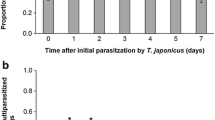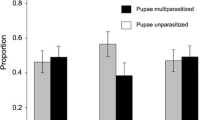Abstract
New associations between parasitoid species is common in biological control with interactions ranging from coexistence to competitive exclusion. Spathius agrili and Spathius galinae, native to North East Asia, are two host-specific idiobiont larval parasitoids of the invasive emerald ash borer Agrilus planipennis that do not overlap in their native ranges but have been recently introduced to the United States for biocontrol of A. planipennis. We conducted laboratory experiments to determine the results of competition between these two species. Competition between parasitoid larvae on a single host (intrinsic competition) and competition between adult parasitoids for oviposition sites (extrinsic competition) were evaluated. Successful multiparasitism did not occur in any intrinsic trials. Extrinsic competition favored S. agrili, but S. galinae was not excluded. Competition lowered parasitism rates for both species, but overall parasitism was not lowered.

Similar content being viewed by others
References
Belokobylskij S, Yurchenko G, Strazanac J, Zaldívar-riverón A, Mastro V (2012) A new emerald ash borer (Coleoptera: Buprestidae) parasitoid species of Spathius Nees (Hymenoptera: Braconidae: Doryctinae) from the Russian Far East and South Korea. Ann Entomol Soc Am 105:65–178
Bray AM, Bauer L, Poland T, Haack R, Cognato A, Smith J (2011) Genetic analysis of emerald ash borer (Agrilus planipennis Fairmaire) populations in Asia and North America. Biol Invas 13:2869–2887
Canadian Food Inspection Agency (2019) Areas regulated for the emerald ash borer. https://inspection.gc.ca/plants/plant-pests-invasive-species/insects/emerald-ash-borer/eng/1337273882117/1337273975030. Accessed 7 Aug 2019
Canadian Food Inspection Agency Emerald Ash Borer (2020a) http://www.inspection.gc.ca/plants/plant-pests-invasive-species/insects/emerald-ash-borer/eng/1337273882117/1337273975030. Accessed 25 Aug 2020
Canadian Food Inspection Agency Emerald Ash Borer (2020b) https://www.inspection.gc.ca/plant-health/plant-pests-invasive-species/insects/emerald-ash-borer/wasps/eng/1371137262586/1371137530758. Accessed 25 Aug 2020
Cappaert D, Mccullough DG, Poland TM, Siegert NW (2005) Emerald ash borer in North America a research and regulatory challenge. Am Entomol 51:152–165
Collier TR, Hunter MS (2001) Lethal interference competition in the whitefly parasitoids Eretmocerus eremicus and Encarsia sophia. Oecologia 129:147–154
Davidson W, Rieske LK (2016) Establishment of classical biological control targeting emerald ash borer is facilitated by use of insecticides, with little effect on native arthropod communities. Biol Control 101:78–86
DeBach P (1966) The competitive displacement and coexistence principles. Annu Rev Entomol 11:183–212
Debach P, Rosen D (1991) Biological control by natural enemies, 1st edn. Cambridge University Press, Cambridge
Duan JJ, Bauer LS, Abell KJ, Van Driesche R (2012) Population responses of hymenopteran parasitoids to the emerald ash borer (Coleoptera: Buprestidae) in recently invaded areas in north central United States. Biol Control 57:199–209
Duan JJ, Bauer LS, Abell KJ, Lelito JP, Van Driesche R (2013) Establishment and abundance of Tetrastichus planipennisi (Hymenoptera: Eulophidae) in Michigan: potential for success in classical biocontrol of the invasive emerald ash borer (Coleoptera: Buprestidae). J Econ Entomol 106:1145–1154
Duan JJ, Watt TJ, Larson K (2014) Biology, life history, and laboratory rearing of Spathius galinae (Hymenoptera: Braconidae), a larval parasitoid of the invasive emerald ash borer (Coleoptera: Buprestidae). J Econ Entomol 107:1–8
Duan JJ, Bauer LS, Abell KJ, Ulyshen MD, Van Driesche RG (2015) Population dynamics of an invasive forest insect and associated natural enemies in the aftermath of invasion: implications for biological control. J Appl Ecol 52:1246–1254
Duan JJ, Schmude JM, Wang XY, Watt TJ, Bauer LS (2018) Host utilization, reproductive biology, and development of the larval parasitoid Tetrastichus planipennisi as influenced by temperature: implications for biological control of the emerald ash borer in North America. Biol Control 125:50–56
Duan JJ, Van Driesche RG, Crandall RS, Schmude JM, Rutledge CE, Slager BH, Gould JR, Elkinton JS (2019) Establishment and early impact of Spathius galinae (Hymenoptera: Braconidae) on emerald ash borer (Coleoptera: Buprestidae) in the Northeastern United States. J Econ Entomol 112:2121–2130
Emerald Ash Borer Information (2019) Emerald ash borer information network. http://www.emeraldashborer.info/. Accessed 28 July 2019
Federal Register (2007) Availability of an environmental assessment for the proposed release of three parasitoids for the biological control of the emerald ash borer Agrilus planipennis in the continental United States. Federal Register 72, 28947–28948 [docket number APHIS-2007–006]. https://www.federalregister.gov/documents/2007/05/23/E7-9895/emerald-ash-borer-availability-of-an-environmental-assessment. Accessed 25 Aug 2020
Godfray HCJ (1994) Parasitoids: behavioral and evolutionary ecology, 1st edn. Princeton University Press, Princeton
Gould RJ, Ayer T, Fraser I (2011) Effects of rearing conditions on reproduction of Spathius agrili (Hypenoptera: Braconidae), a parasitid of the emerald ash borer (Coleoptera: Buprestidae). J Econ Entomol 104:379–387
Hajek A (2004) Natural enemies, 1st edn. Cambridge University Press, Cambridge
Hanks LM, Millar JG, Paine TD, Wang Q, Paine EO (2001) Patterns of host utilization by two parasitoids (Hymenoptera: Braconidae) of the eucalyptus longhorned borer (Coleoptera: Cerambycidae). Biol Control 21:152–159
Jennings DE, Duan JJ, Bean D, Gould JR, Rice KA, Shrewsbury PM (2016) Monitoring the establishment and abundance of introduced parasitoids of emerald ash borer larvae in Maryland, U.S.A. Biol Control 101:138–144
MapBioControl (2019) Agent release tracking and data management for federal, state, and researchers releasing three biocontrol agents released against emerald ash borer. http://www.mapbiocontrol.org/. Accessed 7 Aug 2019
Mercader RJ, McCullough DG, Storer AJ, Bedford JM, Heyd R, Poland TM, Katovich S (2015) Evaluation of the potential use of a systemic insecticide and girdled trees in area wide management of the emerald ash borer. For Ecol Manage 350:70–80
Mills N (2006) Interspecific competition among natural enemies and single versus multiple interactions in biological control. In: Broder J, Bovin G (eds) Trophic and guild in biological interactions control. Progress in biological control. Springer, Dordrecht, pp 191–220
Murphy TC, Van Driesche RG, Gould JR, Elkinton JS (2017) Can Spathius galinae attack emerald ash borer larvae feeding in large ash trees? Biol Control 114:8–13
Myers JH, Higgins C, Kovacs E (1989) How many insect species are necessary for the biological control of insects? Environ Entomol 18:541–547
SAS Institute Inc (2019) JMP Pro 14.0.0. SAS Institute Inc, Gary, NC 2751
Schoener TW (1983) Field experiments on interspecific competition. Am Nat 122:240–285
Siegert NW, Mccullough DG, Liebhold AM, Telewski FW (2014) Dendrochronological reconstruction of the epicentre and early spread of emerald ash borer in North America. J Conserv Biogeogr 20:847–858
Smith HS (1929) Multiple parasitism: its relation to the biological control of insect pests. Bull Entomol Res 20:141–149
Ulyshen MD, Mankin RW, Chen Y, Duan JJ, Poland TM, Bauer LS (2011) Role of emerald ash borer (Coleoptera: Buprestidae) larval vibrations in host-quality assessment by Tetrastichus planipennisi (Hymenoptera: Eulophidae). J Econ Entomol 104:81–86
Wang XG, Messing RH (2004) Two different life-history strategies determien the competitive outcome between Dirhinus giffardii (Chalcididae) and Pachycrepoideus vindemmiae (Pteromalidae), ectoparasitoids of cyclorrhapohous Diptera. Bull Entomol Res 94:473–480
Wang XG, Messing RH, Bautista RC (2003) Competitive superiority of early acting species: a case study of opiine fruit fly parasitoids. Biocontrol Sci Technol 13:391–402
Wang XG, Bokonon-Ganta AH, Messing RH (2008) Intrinsic inter-specific competition in a guild of tephritid fruit fly parasitoids: effect of co-evolutionary history on competitive superiority. Biol Control 44:312–320
Wang XY, Jennings DE, Duan JJ (2015) Trade-offs in parasitism efficiency and brood size mediate parasitoid coexistence, with implications for biological control of the invasive emerald ash borer. J Appl Ecol 52:1255–1263
Watt TJ, Duan JJ (2014) Influence of host age on critical fitness parameters of Spathius galinae (Hymenoptera: Braconidae), a new parasitoid of the emerald ash borer (Coleoptera: Buprestidae ). J Econ Entomol 107:1320–1329
Yang ZQ, Strazanac JS, Yao Y-X, Wang X (2006) A new species of emerald ash borer parasitoid from China belonging to the genus Tetrastichus Haliday (Hymenoptera: Eulophidae). Proc Entomol Soc Wash 108:550–558
Yang ZQ, Wang X-Y, Gould JR, Reardon RC, Zhang Y-N, Liu G-J, Liu E-S (2010) Biology and behavior of Spathius agrili, a parasitoid of the emerald ash borer, Agrilus planipennis, in China. J Insect Sci 10:30
Yang S, Duan JJ, Watt T, Abell KJ, Van Driesche RG (2012) Responses of an idiobiont ectoparasitoid, Spathius galinae (Hymenoptera: Braconidae), to host larvae parasitized by the koinobiont endoparasitoid Tetrastichus planipennisi (Hymenoptera: Eulophidae): Implications for biological control of emerald ash borer. Environ Entomol 41:925–932
Yang S, Duan JJ, Lelito J, Van Driesche R (2013) Multiparasitism by Tetrastichus planipennisi (Hymenoptera: Eulophidae) and Spathius agrili (Hymenoptera: Braconidae): implication for biological control of the emerald ash borer (Coleoptera: Buprestidae). Biol Control 65:118–123
Acknowledgements
I would like to thank Erin Langton-Ragozzino, Becca Robertson for help rearing EAB and S. galinae, and Jonathan Schmude for help with materials and supplies. Thank you to Miranda Pacheco for copy-editing versions of this manuscript and to Liam Sullivan and Beckie Kanterman for additional early review. Additional thanks go to the staff of the Brighton, MI USDA Rearing facility, who reared S. agrili, without them this experiment would not be possible. This research was funded through United States Forest Service grant 15-DG-11083150-042 and United States Department of Agriculture Research Service grant 58-8010-5-016.
Funding
This research was funded through USFS Grant 15-DG-11083150-042 and USDA ARS Grant 58-8010-5-016.
Author information
Authors and Affiliations
Corresponding author
Ethics declarations
Conflict of interest
None.
Data availability
Available upon request.
Additional information
Publisher's Note
Springer Nature remains neutral with regard to jurisdictional claims in published maps and institutional affiliations.
Rights and permissions
About this article
Cite this article
Ragozzino, M., Duan, J. & Salom, S. Interspecific Competition Between Idiobiont Larval Parasitoids of Emerald Ash Borer. J Insect Behav 34, 186–193 (2021). https://doi.org/10.1007/s10905-021-09781-1
Received:
Revised:
Accepted:
Published:
Issue Date:
DOI: https://doi.org/10.1007/s10905-021-09781-1




